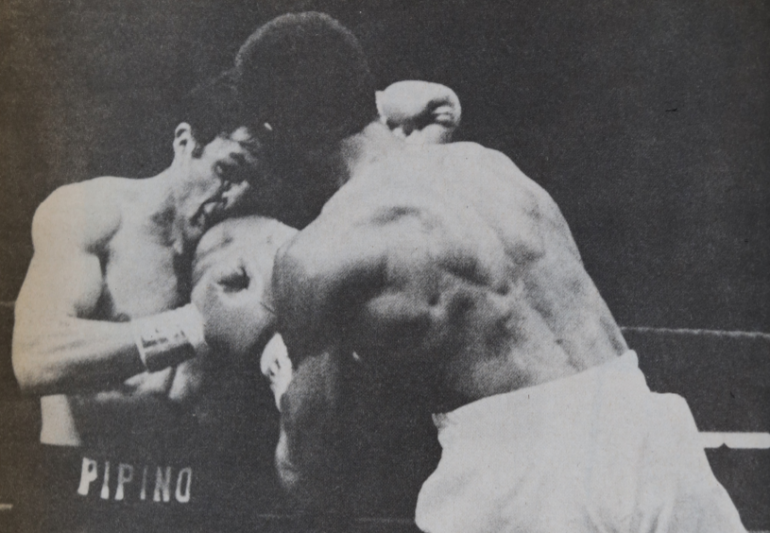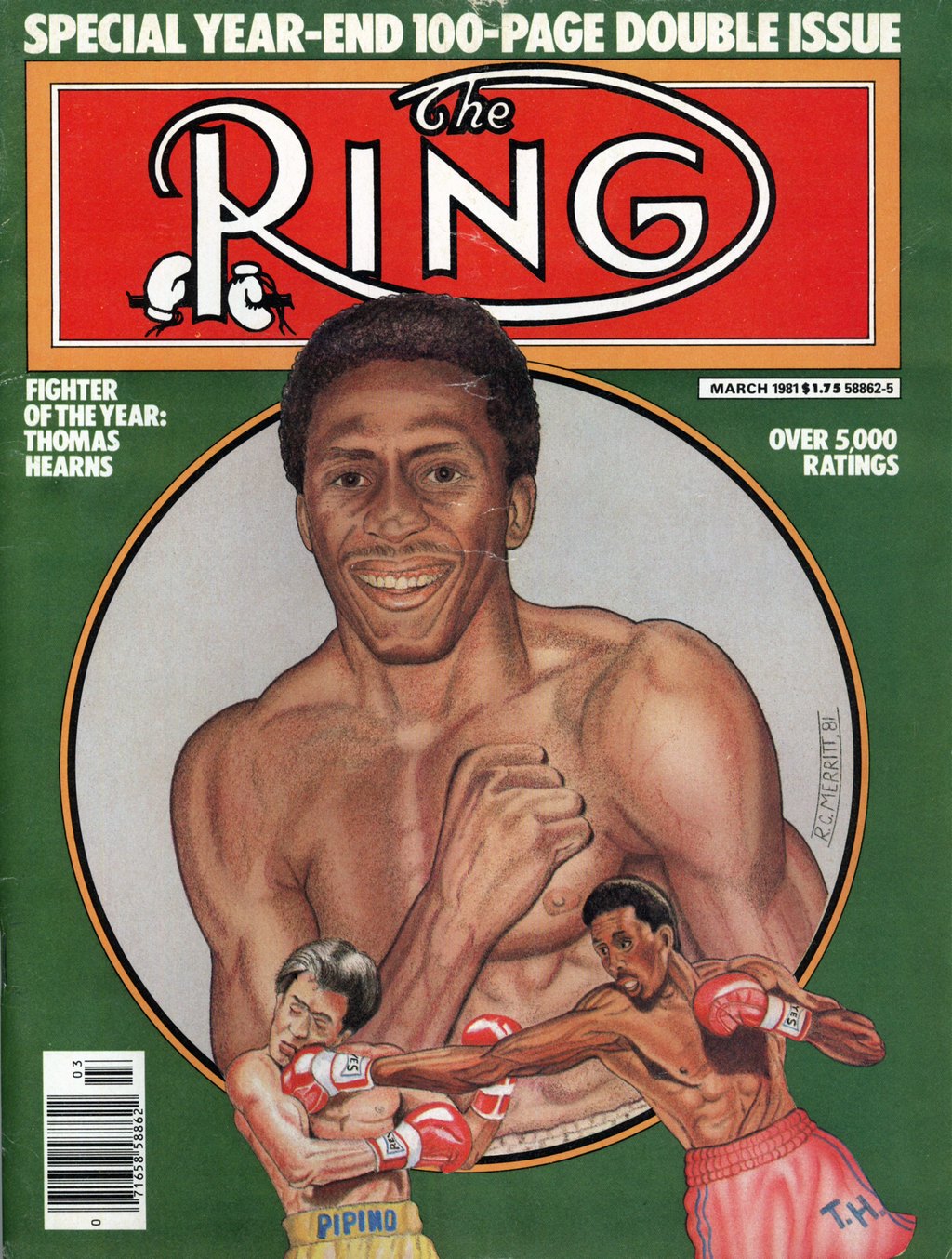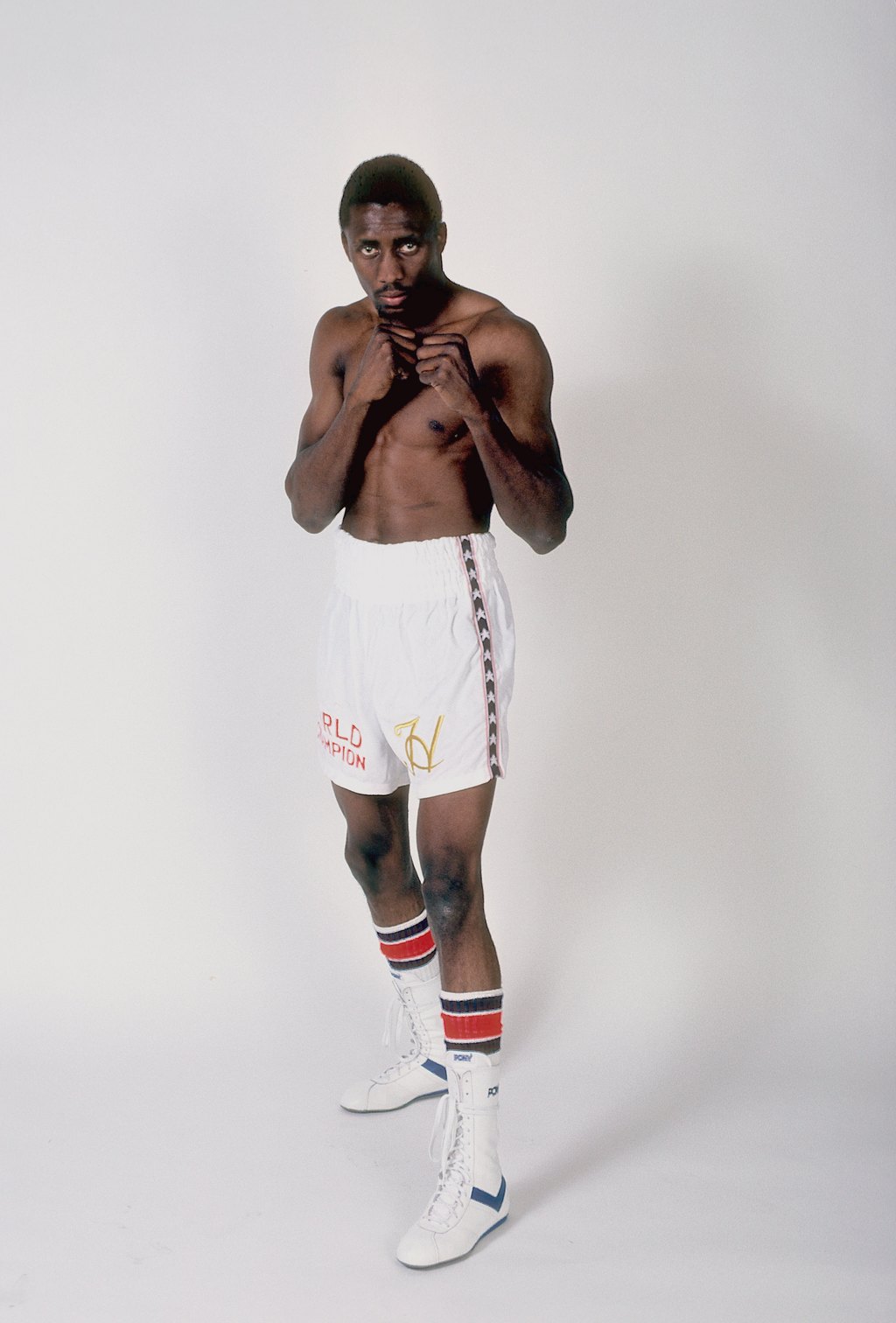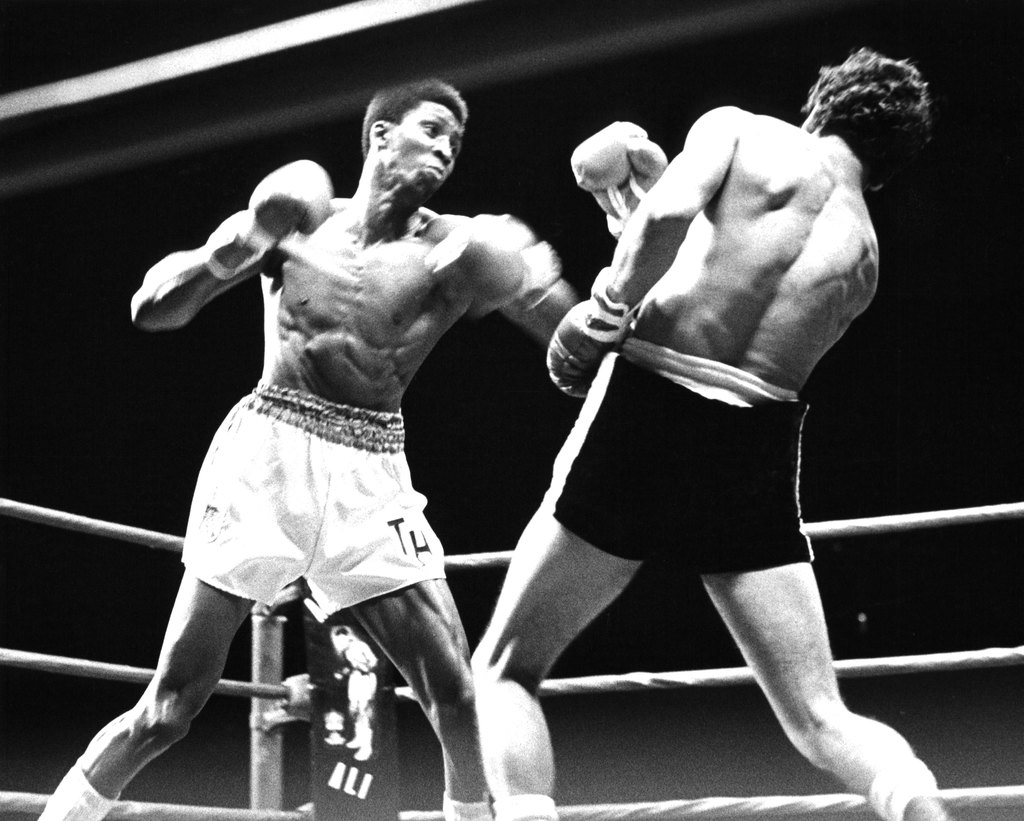From the Archive: Thomas Hearns Q&A following Pipino Cuevas destruction

The following feature appeared in the October 1980 issue of The Ring Magazine.
By Randy Gordon
HE LOOKED TALLER THAN EVER BEFORE, taller than the 6-foot-1 the press releases said he was, taller even than the 6-foot-2 ½ his recent measurements showed him to be. He has been up to visit The Ring offices before, and although he looked tall then, he was not nearly as tall and powerful-looking as he seemed on this occasion. Perhaps that’s because, since his last visit, he had knocked out the seemingly invincible Pipino Cuevas.
Nobody had ever done that to Cuevas before. Nobody. Not only was Cuevas never knocked out, he was never knocked down, never even staggered. Punches had – in 33 previous pro fights – bounced harmlessly off his chin as he pressed ever forward behind two sledgehammers that he calls his fists.
Unbeaten since 1976, Cuevas was expected by many to dispatch Thomas Hearns much in the manner he dispatched 24 other opponents – quickly and ruthlessly. It was not to be.
Five minutes and 39 seconds after the fight began, a new champion was crowned. The almighty Cuevas had been outclassed, outgunned, beaten up and stretched face down on the canvas.

March 1981 issue.
A new devastating welterweight king had been coronated. Immediately, the talk began of him going on to greatness, surpassing such immortal welterweights of yesteryear as Ted “Kid” Lewis, Jack Britton, Henry Armstrong, Emile Griffith, Jose Napoles and ever Sugar Ray Robinson, considered by many to be the greatest 147-pounder of all.
As an amateur, Hearns never gave the indication that he was heading towards greatness. In 163 amateur fights (of which 155 were victories) he kayoed a total of just 12 opponents. The figure is indeed staggering when one stops to compare Hearns’ amateur knockout percentage (0.074) against his professional knockout percentage (0.931) – the best in welterweight history.
“As an amateur, he was a super boxer,” said manager-trainer Emanuel Steward of Hearns. “He’d jab, jab, jab, fire his right, then dance away. He didn’t know what a left hook was and he didn’t know what leverage was. Then he started to grow and started to learn. The power was always there, only he didn’t know how to use it. Now he does, and the results, as you have seen, are awesome.”
Hearns was born on the rough East Side of Detroit on October 18, 1958, one of eight children. Never a lawbreaker, Hearns had his share of street fights until he began boxing as an amateur, at the age of 10.
“From that time on,” recalls Hearns. “I was left alone.”
Almost from the beginning of his amateur Hearns wanted to be a world champion.
“All I ever thought about was being a boxer, winning a title, being a boxer, winning a title. I never stopped dreaming.”
As a light-hitting 16-year-old amateur, Hearns won the 119-pound title in the Michigan Golden Gloves and the Midwest Regional Championships. In 1976, fighting with a broken nose that kept him on the run – as well as in severe pain – Hearns lost a decision in the finals of the National AAU championships in Vegas. His opponent: Howard Davis Jr.
Later that year, Hearns again lost in the finals of a major amateur tournament, the National Golden Gloves. This time he was beaten by Aaron Pryor.

Hearns in May 1981. Photo from The Ring archive
In 1977, Hearns, up to 139 pounds, was improving rapidly. That year he beat the highly-regarded Bobby Joe Young for the National AAU title and followed with a victory in the finals of the National Golden Gloves. In international competition, Hearns lost only once in 12 fights.
Figuring there was no more amateur worlds to conquer and believing he was no ready to begin his quest for a professional world title, Hearns turned professional on November 25, 1977, against Jerome Hill in Detroit. Hearns won by what is now regarded as a Thomas Hearns trademark, an early knockout. Since that victory, Hearns has flattened 26 additional opponents. Only Alfonso Hayman and Mike Colbert have survived the 10-round distance against Hearns. In the April 1979 fight against Hayman, Hearns injured his right hand and fought the last five rounds without using it. In the November 1979 fight against Colbert, a middleweight, Hearns won a one-sided 10-round decision, knocking Colbert down four times and breaking his jaw in the process.
As Hearns talked to Associate Editor Randy Gordon in the offices of The Ring – offices fairly dripping with the history of boxing – Steward looked at the memorabilia in the Boxing Hall of Fame. He smiled all the while.
Steward should smile. For he manages not only the WBA welterweight champion, the man whom he believes will go on to win the junior middleweight, middleweight and light heavyweight titles, but the man he also believes will become one of the greatest champions boxing has ever produced. And whom, one day in the not too distant future, he believes will be enshrined in that same Hall of Fame.
THE RING: Great fight, Champ. How do you like the sound of the word ‘Champ?’
THOMAS HEARNS: “Thank you. I love it. It sounds great. But I’ve considered myself ‘the champ’ for a long time.”
THE RING: What do you want to do with the title now? Will you give Cuevas a rematch?
TH: “I think that’s a fair thing to do. I’d also like to fight Duran. But I feel that it’s only fair that once you take a title from a person, you should give him a rematch.”
THE RING: Do you think Cuevas would want a rematch?
TH: “Not really. I really laid some shots on him, especially that last right. Besides, no man I’ve ever fought has asked for a rematch. After Cuevas sees the films, he certainly won’t want one.”
THE RING: Are you certain he wouldn’t want one?
TH: “I’m certain. Get a hold of him. Go ask him.”
THE RING: We already did. An associate of his said there is no way he wants to fight you again. Did you hear that he called you ‘a great fighter?’
TH: “Yes, I did. That was nice of him. And coming from him – a man I think was a great champion – that really means something.”
THE RING: In 1980, take a look back at what you’ve done. You’ve flattened Santiago Valdez and former junior middleweight champion Eddie Gazo in one round, Jim Richards in three, Angel Espada in the fourth. Now you’ve capped it all by destroying Pipino Cuevas inside two. Don’t you think that’s an impressive record?
TH: “Yes, I suppose it is. I always try to keep a trick or two up my sleeve. For Cuevas, my trick was to back him up, open him up with my jab, then look for his chin with my straight right.
THE RING: You certainly found that chin. Were you surprised he got up?
TH: “If it had been anybody else, I would have been surprised. But Cuevas had been known for having a great chin. But listen, we’re all human, and when that kind of punch hits you, like the right I hit him with, a man has to drop. It would have frightened me if he didn’t fall.”
THE RING: On several occasions, you’ve been quoted as saying that you don’t like it when people call you “Hitman.” Do you still dislike the nickname?
TH: “Everyday people come by and say ‘Hitman’, what’s happening?’ or ‘Hitman, what’s doing?’ It’s just something that was started, just like the ‘Motor City Cobra,’ and it stuck.
THE RING: Do you like the ‘Motor City Cobra’ better?
TH: “Yes, much better. But now I’m used to ‘Hitman.’ I don’t really like it, but I’m used to it.
THE RING: Pipino Cuevas would never deny that you’re a hit man, especially after spending less than six minutes with you.
TH: “That’s for sure.”
THE RING: Do you know that your knockout average is the highest of any welterweight champion ever?
TH: “No, I didn’t know that. I plan to keep it that way!”

Hearns (left) against Jose Figueroa. Photo from The Ring archive
THE RING: While everyone seems to be talking about your fight against Cuevas, how about a few of the other top names in the division – Roberto Duran, Sugar Ray Leonard and Wilfred Benitez?
TH: “I would like to fight any one of them. But I’d like to take on Leonard last.”
THE RING: Why?
TH: “He made me wait for a title shot. Now I’ll make him wait. I’ll especially make him wait if I fight Duran. After I beat him and hold the only title in the division, I’ll make Leonard wait and wait, just like he did to me.”
THE RING: Do you think you’d have a rough time with any of the welterweights I just mentioned?
TH: “No, not at all. I don’t see any of the contenders giving me a rough time. I told you, I’ve considered myself champion for a long time.”
THE RING: There are a few questions to be answered about you. One is, can you take a good rap on the chin? Cuevas never got to test your chin.
TH: “I think I can take a hard punch. But who wants to? I want to get hit as little as possible. I don’t want to go into the ring to take blows and punches upside my head.”
THE RING: The other question mark over your career is whether or not you can fight 15 hard rounds.
TH: “I can – if I have to. I try to get hit as little as possible and try to end a fight as quickly as possible. But if it ever comes down to real hard, long fight, you’ll see me in there fighting as hard as I have to for as long as I have to.”
THE RING: Are you going to be moving up to the junior middleweights and middleweights? You had trouble making 147 for the Cuevas fight, going into a sauna for an hour before the weigh-in.
TH: “Maybe one day, but not right now. I still can make 147 pounds without really weakening myself.”
THE RING: Weakening yourself. You could probably fight at 148 or 149 and hold your own against the entire junior middleweight division and just about every world class middleweight.
TH: (Smiling shyly) “Thanks, but time is on my side. I’ll be 22 in October. I’m not going to force anything. If I grow, I grow.”
THE RING: Did you train any differently for Cuevas than you did for anybody else?
TH: “Not really. I trained the way I always train – hard! I take every opponent seriously. You’ll never see me step into the ring unprepared. What the bell rings, I’m ready. I was ready for Cuevas and everything he could throw at me. You saw what happened.”
THE RING: Because so many young fighters and fans emulate the great fighters, can you give them a few training tips or secrets?
TH: (Smiling) “Well, I don’t have any training secrets. If you know of any, please give them to me. I run six miles every morning at seven o’clock. I run at various speeds. Sometimes I run five miles easy, then try to sprint the last mile. Other times, I run as hard as I can for six miles. A fighter should try and vary his running speed. In the gym, I don’t vary. In the gym, I work hard. Fighters should always work hard. Fighting is hard. It’s a rough business. If you’ve trained hard, if you’ve run hard, you’re ready in case the fight is hard.”
THE RING: How about your diet? Any secrets?
TH: “Nope. Again, no secrets. I eat lots of fruits and vegetables. I try to keep away from greasy food. I don’t do anything different in my diet than any fighter should do.”
THE RING: How about the age-old taboo – “Sex before a fight?”
TH: (Laughing) “Are women listed under ‘diet?’ Well, in a big fight, especially one as big as the Cuevas fights, you have to overlook and ignore a number of things.”
THE RING: How long before a fight do you keep away from . . .
TH: “Away from women? Oh, about six to eight weeks. Before a fight, the fighter should be thinking about the fight. Only about the fight.”
THE RING: Don’t you think women can be relaxing?
TH: “Sure they can. But they’re also distracting. A fighter should not go around being so relaxed. He should be ready to fight. For those who never noticed, there’s a difference between fighting and . . .
THE RING: We’ve noticed! Are you a fight fan? Do you watch all the fights on TV?
TH: “No, I don’t know all the champions. There’s a lot of them and there’s a lot of divisions. I’m usually doing many different things and running around whenever there’s a fight on. But if I’m home and there’s a good fight on, I’ll watch it. I like to get out and participate in other sports. I like to play basketball and roller skate. I’m not a great roller skater but I enjoy it. I’m good enough to stay up enough without falling.”
THE RING: Do you watch tapes of your opponents?
TH: “Sometimes. But I don’t study those tapes the way some fighters do. I don’t believe tapes are all that helpful. Your opponent is not gonna fight the same kind of fight against you as he did against somebody else.”
THE RING: What do you see for Thomas Hearns? What’s down the road?
TH: “A great future. I see Thomas Hearns being champion of the world for a long, long time.”
READ THE LATEST ISSUE OF THE RING FOR FREE VIA THE NEW APP NOW. SUBSCRIBE NOW TO ACCESS MORE THAN 10 YEARS OF BACK ISSUES.















